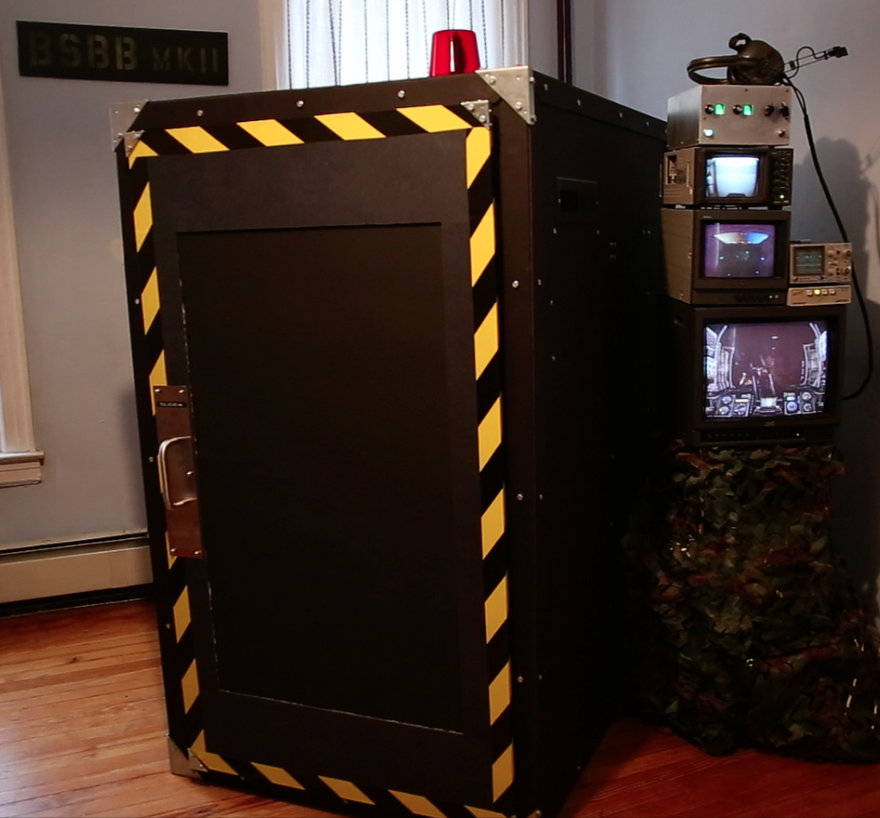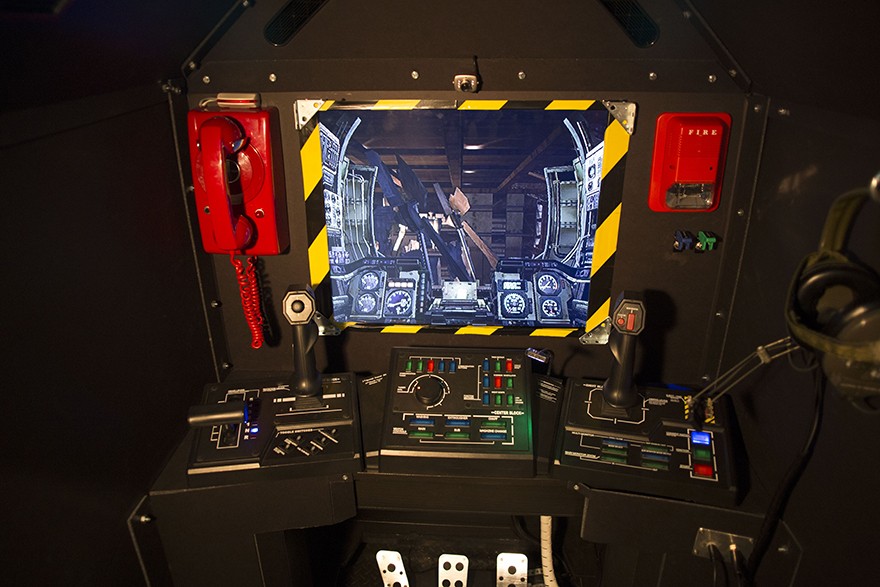Update 11/24/14: Hey Reddit! Consider following us on Twitter or adding us to your Feedly for more stories from the intersection of games, art, and culture.
Update 3/27/15: Check out the B.S.B.B. Mk II website! The Box will be at Bay Area Maker Faire 2015 during the week of May 16.
As I waited in David Shuff’s kitchen, stylized as the “mess hall,” watching the jumpsuit-donned crew members prepare “The Big Steel Battalion Box” (B.S.B.B.), I noticed a Gundam model catalogue on the wall. This guy loves mechs, I thought to myself.
The man himself looked excited as he hustled about his Brooklyn residence in olive green fatigues, a patch reading “Shuff” fully visible. The B.S.B.B. has been a long-term project for the digital media professional, and he wanted to unveil it with a bang.
This was to be my first experience with the game that inspired it—that is, the infamous Steel Battalion, in which players pilot an enormous bipedal mech. I noticed the game’s peripheral for the first time in Official Xbox Magazine many years ago, but 11-year-old me never understood why his parents said he was “ridiculous” for wanting it. Looking back, though, it’s clear what was preposterous: the required peripheral is a massive panel with around 40 buttons, two joysticks, as well as pedals. Its complexity made Steel Battalion a game that alienated pretty much everybody, both through its cost and the difficulty of its operation.
But, with The B.S.B.B., Shuff takes the ridiculous knob and shifts it into overdrive. Set up like a decked-out driving simulator, the claustrophobically-sized refrigerator box contained a variety of lights and other switches, as well as hidden electronics to enhance both the audio output and rumbling of the game.

The peripheral is what makes the experience feel alive. That attention to detail and the atmosphere of the box goes to waste if you’re sitting there with an Xbox controller in your hand. The controller allows the low-poly graphics to age gracefully, as the giant control panel is the majority of the experience.
“This is fucking HD forever,” Shuff said.
I was intrigued for what was to come: one player was to be a pilot while another player took the role of coach, standing outside the box and viewing a feed of the action with an aptly named “Steel Battalion For Dummies” guide written by Shuff. The coach would give the pilot directions as they proceeded through the level. Skill was discouraged.
Shuff said his idea for the experience was derived from his first chaotic experience with Steel Battalion, where his friend just started to play with no knowledge of the controls, while Shuff was relegated to flipping through the giant manual trying to figure out what was going on.
“There’s a big ka-thunk, and he was like, ‘what do I do?,’” Shuff said, laughing. “And then I’m like, uh, you ejected the fuel tank.”

We got the go-ahead to head downstairs to the room containing a Metal Slug cabinet and the B.S.B.B. It was unassuming at first, other than some analog monitors on the side of the box attached to refurbished Chinese military surplus headsets. This system, put together by Leon Dewan of the electronic music manufacturer Dewanatron, would serve as the method for pilot-coach communications.
The production value showed a real enthusiasm. As the door was opened for our first pilot, 11-year-old me smiled.
“This is so fucking cool,” I hear from the pilot, Jan-Luc, as he starts the ignition sequence. The box rumbles from the game volume. Shuff explains that with the headsets being surplus, they have aggressive soundproofing as they were used in helicopters. But rather than keep the volume low, he decided it would be more authentic to make the game sound as loud as possible.
Jan-Luc makes his way through the level, encountering his first enemy vertical tank (V.T.). He locks-on, destroying it. “Nice,” Shuff exclaims, encouraging him through the headset.
It eventually came to my turn. I was nervous, thinking, “I have no idea what I’m doing.” Shuff had added a direct phone line to the cockpit (626) 788-BSBB. I texted it to my girlfriend in hopes of some words of encouragement before I dove in, but I was left empty-handed.

The headset crackled perfectly, sounding like analog radio chatter instead of a phone call, as my coach directed me on the proper startup sequence; after engaging the major systems by flipping an array of switches I had to hit the ignition at the right moment in order to not stall out the engine. I get acquainted with the joysticks, shift into first gear and take my first steps.
As Shuff says to me later, “The game blows its wad early.” It never gets much better than the early moment when you look at the full control panel, start up the mech, and the box shakes as the vertical tank comes to life. Even as the mech lumbers on, and I annihilate a line of lighter enemy units with machine gun first and lock-on and destroy an opposing robot with a flurry of shells, I still look back to those first few moments with delight.
I complete my run shortly after embarrassingly flipping my mech over, ejecting from the cockpit and taking a brief moment to recollect my thoughts. I start to understand why this works. The B.S.B.B. walks a fine line between videogame and simulator with poise—half the game is in the physical world with you.
To wit: A sequel to the game was released a few years ago for Kinect. The touch controls were unresponsive, and the loss of physical feedback eliminated the connection with it. With the original, you get the sense that the creator developed the controls, then made a game for them.
Shuff understands this, and by building on the original peripheral and playing to its sense of tactile connection, he’s found a way to revitalize an under-played classic.
Header, setup and cockpit images and video courtesy of David Shuff
